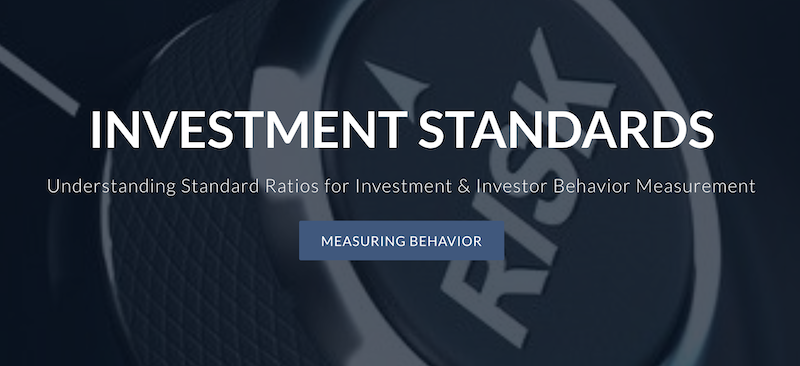Why the Modern Portfolio Theory is flawed and can be misleading ?
by Charlie Q. Yang, Ph.D., CFP®, AAMS®

The general understanding of the financial industry has been that return and risk are real and fundamental. Therefore we have been so used to and positive for any description of the capital market by Nobel Prize-winning economics works. That led us to believe that the modern portfolio theory and related academic research are true descriptions of the market.
If we have observed the stock market movements more in-depth and long enough, many of us have seen evidence that return and risk (standard deviation) are not fundamental. They are derived or emergent concepts. We all know what temperature means. It measures something as hot or cold. Scientific discoveries taught us that temperature is just an emergent idea and the fundamental idea is the motions of atoms.
From the day in 1995 when I discovered how unreliable and inaccurate the Normal distribution (bell-curve) is when being applied to the stock market movement as a statistical model, I started to question the financial industry’s academic foundation. What Wall Street has been using are all the derived capital market measures from the modern portfolio theory. They are just emergent ideas. They are all built on unrealistic and oversimplified assumptions on their roots and thus can be so easily misused to make the theory superficial and flawed, even to cause a financial crisis.
My original goal of this new dimension of financial market research is to discover the scientific phenomena governing each trading tick’s movement (similar to atoms in physics).
Since 1996, I have captured my findings through the framework named the Capital Market Behavior Theory (CMBT). These new scientific discoveries have been validated by real-time market data for over 20 years. I am thrilled to pronounce that we can pinpoint the actual fundamental ingredients that formulate our investment concepts of return and risk.
If we have observed the stock market movements more in-depth and long enough, many of us have seen evidence that return and risk (standard deviation) are not fundamental. They are derived or emergent concepts. We all know what temperature means. It measures something as hot or cold. Scientific discoveries taught us that temperature is just an emergent idea and the fundamental idea is the motions of atoms.
From the day in 1995 when I discovered how unreliable and inaccurate the Normal distribution (bell-curve) is when being applied to the stock market movement as a statistical model, I started to question the financial industry’s academic foundation. What Wall Street has been using are all the derived capital market measures from the modern portfolio theory. They are just emergent ideas. They are all built on unrealistic and oversimplified assumptions on their roots and thus can be so easily misused to make the theory superficial and flawed, even to cause a financial crisis.
My original goal of this new dimension of financial market research is to discover the scientific phenomena governing each trading tick’s movement (similar to atoms in physics).
Since 1996, I have captured my findings through the framework named the Capital Market Behavior Theory (CMBT). These new scientific discoveries have been validated by real-time market data for over 20 years. I am thrilled to pronounce that we can pinpoint the actual fundamental ingredients that formulate our investment concepts of return and risk.
|
|
Institute for Systematic Investment Research (ISIR) is dedicated to the scientific formulation for measuring "random" and "irrational" market behaviors. In contrast to the well-known modern portfolio theory (MPT) that places oversimplified assumptions on the market prices (returns) and risks (standard deviations), our research topics are focusing on measuring the psychological effect of investing activities in the following four areas:
|
|
Market Cycle Indicator
Market Behavior Theory - the new Yin-Yang Index and better simulation.
Learn More ... |
Risk Assessment
Market distorts investor's true risk tolerance. The new 4T-10C system.
Learn More ... |
Risk-Adjusted Return
Risk aversion, maximum draw-down, and the new Calmar-Yang Ratio.
Learn More ... |
Theme Benchmark
From market indexes to the new Theme-Based Benchmarks.
Learn More ... |
"Total investor confidence must come from science, not from flawed art. Investing being still more art than science only means we have more to learn and discover. For the best interest of investors, we must scientifically validate any investment strategy to make sure it adds value as compared to its corresponding benchmark."
- Charlie Q. Yang (2000)
Background:
Most investors today thought their advisers doing a "good" job merely based on positive returns, without realizing that most advisers actually did not add value at all when compared to other better and lower cost alternatives. Many times even institutional investors were fooled by "smart" managers who claimed to apply the modern portfolio theory (MPT) for portfolio construction and charged high fees for doing a "great" job. Even the newer developments in "Smart-Beta"; "Factor-Investing", and "Robo-Advisor" are still all based on the fundamentally limited MPT that assumes the perfect symmetric financial market (bell-curve) without preparing for the possible highly volatile actions driven by human emotions.
Unfortunately, with the MPT, the behavioral content is ignored and only price volatility characterized by the standard deviation or beta is considered. The oversimplified assumptions created the MPT have been the root cause of many serious problems facing the financial industry (such as the 2008 financial crisis). Wall Street's greed to higher profit only made the situation worse. Many fundamentally flawed strategies were not challenged at the early stages and often not discovered until big losses resulted. Investors were left vulnerable without the knowledge to understand why and how to protect them in the future. If you see investing is more of an art than a science, that should be the past.
Since 1996, we are working with investors and researchers to make investing activities measurable and more of a science. With the discovery of Q-Distributions and dual-mode market statistics by Dr. Charlie Q. Yang in 1994, for the first time in history, it enabled researchers to generate a family of fat-tailed and skewed probability distributions for more accurately modeling market risks and asset return statistics as derived by investors’ behavior. The earlier research led to the later discovery of the Capital Market Behavior Theory (CMBT). The theory was not published before but instead put into a computer system being validated against real market data for the purpose of verifying the scientific findings. This evolved into the systematic implementation of the Yin-Yang Index (YY-index) as a new scientific indicator of primary market cycles (completed in 2003). The back-testing studies show that CMBT and the YY-index timely detected all primary market cycle transitions in 2003, 2007, 2009, and 2015. We have further developed a set of scientific measuring standards based on CMBT principles to help evaluate and improve the quality of investment products and services for investors.
Most investors today thought their advisers doing a "good" job merely based on positive returns, without realizing that most advisers actually did not add value at all when compared to other better and lower cost alternatives. Many times even institutional investors were fooled by "smart" managers who claimed to apply the modern portfolio theory (MPT) for portfolio construction and charged high fees for doing a "great" job. Even the newer developments in "Smart-Beta"; "Factor-Investing", and "Robo-Advisor" are still all based on the fundamentally limited MPT that assumes the perfect symmetric financial market (bell-curve) without preparing for the possible highly volatile actions driven by human emotions.
Unfortunately, with the MPT, the behavioral content is ignored and only price volatility characterized by the standard deviation or beta is considered. The oversimplified assumptions created the MPT have been the root cause of many serious problems facing the financial industry (such as the 2008 financial crisis). Wall Street's greed to higher profit only made the situation worse. Many fundamentally flawed strategies were not challenged at the early stages and often not discovered until big losses resulted. Investors were left vulnerable without the knowledge to understand why and how to protect them in the future. If you see investing is more of an art than a science, that should be the past.
Since 1996, we are working with investors and researchers to make investing activities measurable and more of a science. With the discovery of Q-Distributions and dual-mode market statistics by Dr. Charlie Q. Yang in 1994, for the first time in history, it enabled researchers to generate a family of fat-tailed and skewed probability distributions for more accurately modeling market risks and asset return statistics as derived by investors’ behavior. The earlier research led to the later discovery of the Capital Market Behavior Theory (CMBT). The theory was not published before but instead put into a computer system being validated against real market data for the purpose of verifying the scientific findings. This evolved into the systematic implementation of the Yin-Yang Index (YY-index) as a new scientific indicator of primary market cycles (completed in 2003). The back-testing studies show that CMBT and the YY-index timely detected all primary market cycle transitions in 2003, 2007, 2009, and 2015. We have further developed a set of scientific measuring standards based on CMBT principles to help evaluate and improve the quality of investment products and services for investors.






